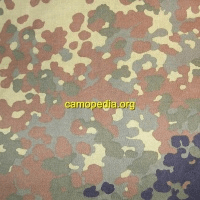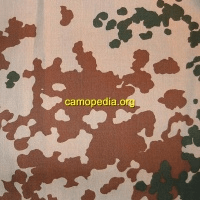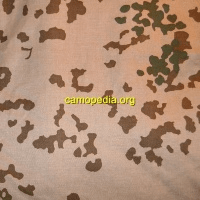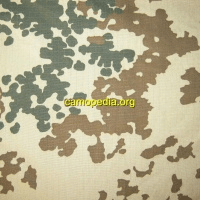Camouflage pattern Tropentarn (GER) BW Tropic, Flecktarn desert
Just like in the case of other countries around it (and other friendly NATO countries), Germany has found it necessary in modern times to maintain its units around the world during times of peace and war. This effort began around the mid-1990s. This led to a new need to equip all its units with camouflage patterns/uniforms/tarps and similar equipment designed for tropical, or desert environments. Due to this need, another version of "Funf Farben Tarndruck der Bundeswehr" ("five-color camouflage for the Bundeswehr") was created and adopted, also nicknamed "Tropentarn." This version was printed on lighter fabric, which is a logical choice for everything in hot areas. This camouflage uniform for the entire military ensemble in hot areas was officially adopted in 2001. Regarding the camouflage itself, it is only a slight modification of the traditional "Flecktarnmuster."

Following the trends set by its other NATO partners (primarily the United Kingdom and France), Germany also began testing desert camouflage based on the scheme of the standard-issued Flecktarn in 1993. Originally, this feature was called "Tropentarn" (literally: "tropical camouflage"), even though it was an entirely unofficial term. In any case, early versions of this camouflage pattern consisted of these colors: sparsely distributed dark olive + reddish brown, all on a sandy background. This desert pattern remained in testing until around 1998-1999, and only then did its first official version appear, subsequently giving rise to Germany's first historical desert uniform. Officially, they were referred to: "drei Farben Tarndruck der Bundeswehr," or also "Three-color camouflage for the German Army." This camouflage is usually referred to as "Wüstentarndruck" ("desert camouflage") or as "Desert Flecktarn pattern" in English-speaking sources.
Although rumors have existed for many years that there are actually two versions of this German desert camouflage pattern, German sources themselves suggest that this is (technically) untrue. Earlier versions of these camouflages (from 1993-1998) had slightly different hues, but only the official version from 1999 is standardized. It is definitely worth mentioning that when washed with other differently colored items, it often changes color slightly. To conclude, this three-color desert camouflage is standard for the German armed forces deployed in dry desert areas (as its design suggests, ideally with sparse vegetation nonetheless).









































































































































